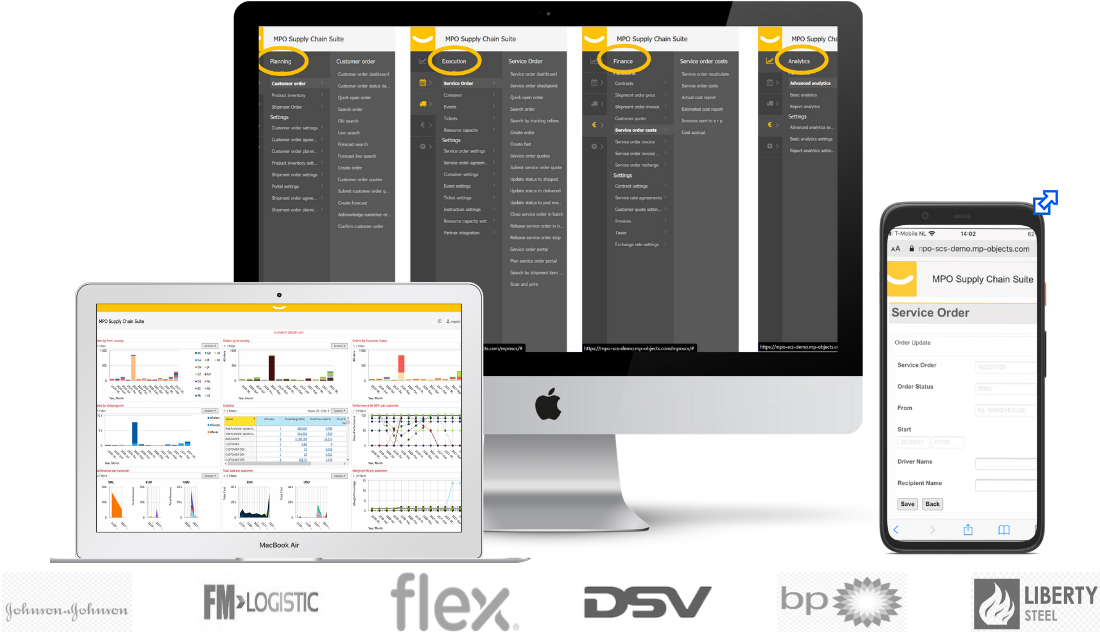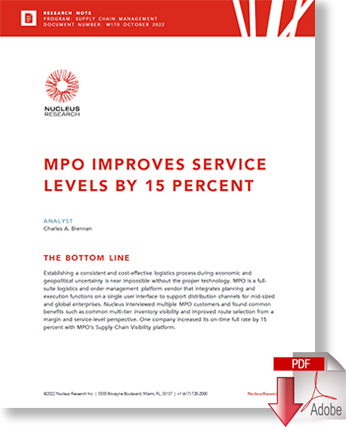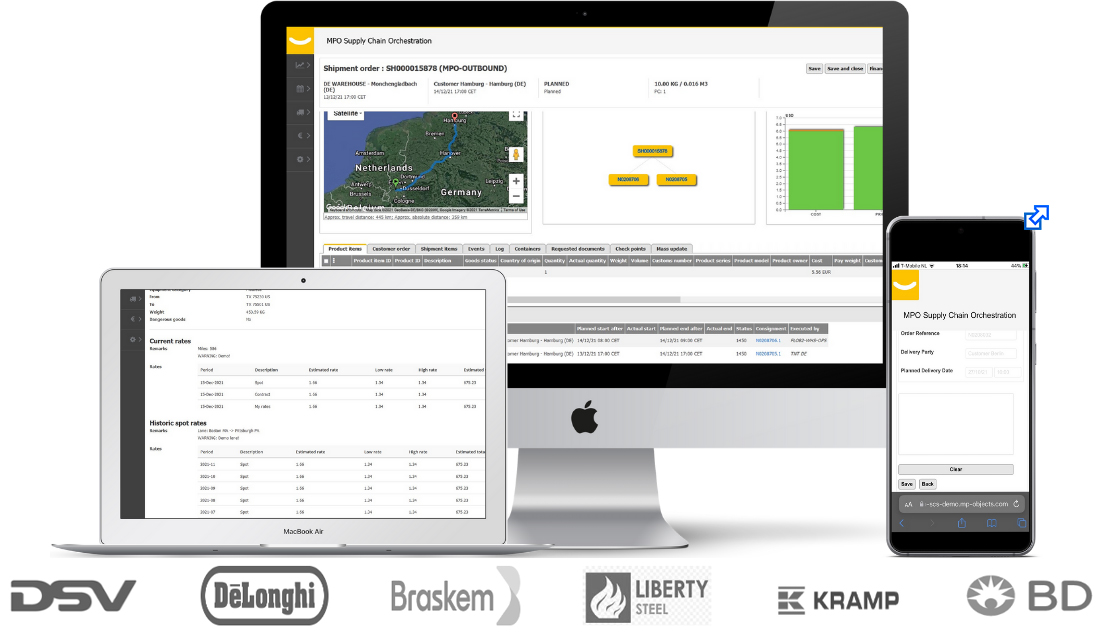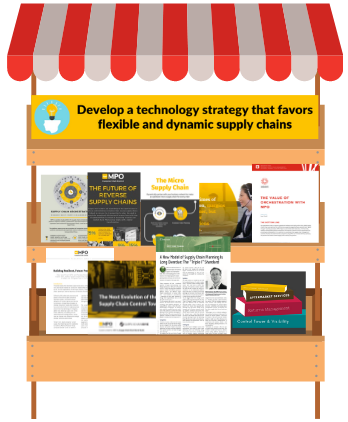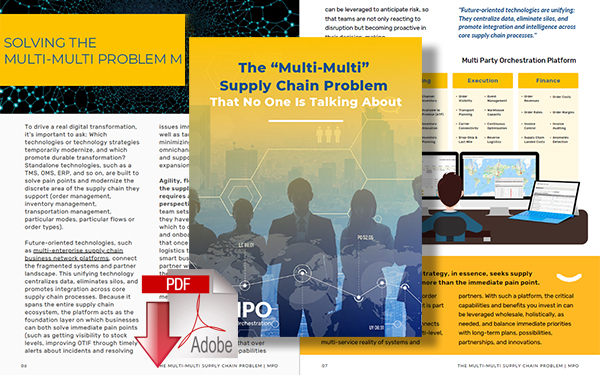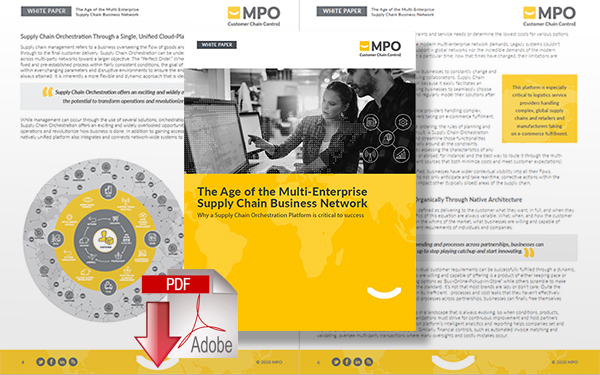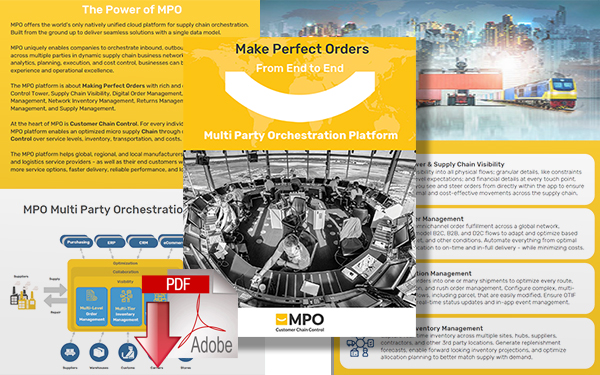Will the Supply Chain Improve and What Does Agility & Resiliency Mean in 2023?

The supply chain is comprised of the market and socio-economic-political conditions, but it is also comprised of people, people who can intelligently plan and continuously optimize execution across the network to enable your company to be resilient.
The Supply Chain Has Been Through a Lot
We, the Supply Chain, have been through a lot these past few years.
After thinking we had operations under control with just-in-time supply chains, leaning out our processes, and modernizing our IT systems, we got hit with geo-political tariffs.
This was followed by shutdowns due to the Covid pandemic, shortages, and backlogs, a fast shift to online commerce, omnichannel selling, and remote working just to survive.
Some industries were literally pummeled, while other industries, especially those in the technology and software business, never had it so good.
So, what have we learned from all of this, and what is our prognosis for a resilient supply chain?
Unfortunately, we are still left with a mixed bag of options.
So let’s look at where we are and where we could be headed.
The Supply Chain Prognosis | Delays and Backlogs
The problem: Business leaders report that their current supply chain issues are mainly owed to global political unrest and a lack of raw materials.
Congestion and backups at various distribution points, such as ports and rail yards, and container shortages, further contributed to backlogs and transportation delays in 2022.
In the U.S., shippers were plagued by railroad service constraints, as well as backlogs at East Coast ports when businesses sought an alternative to the West Coast. Spot rates for containers, tankers, and air freight shipments are coming down fast.
The outlook: While freight congestion has eased and all signs point to transportation delays improving in 2023, it was not long ago that transportation capacity was stretched beyond its limits.
Even if the imbalance has corrected itself, companies must accept that capacity and congestion issues will continue to crop up and should always be prepared or have processes and solutions in place that help minimize impact.
What you can do about it: Some companies are becoming intermodal to reduce reliance on drivers or any specific carrier.
Similarly, diversifying partners relieves a business’ reliance on any one supplier and partner, alleviating material shortages and delays.
The alternatives are not quick-fix solutions that will have you resilient overnight; rather, they are part of long-term strategies organizations are realizing as non-negotiable in volatile supply chains.
Read the Article: Modernizing Is Not Digitally Transforming - So what’s the Right Path for You and Your Company?
To ensure a smooth and fast-time-to-value transition, companies are adopting supply chain technology platforms that allow them to onboard and connect with new partners quickly.
Intelligent Multi-Party Orchestration
SUPPLY CHAIN MANAGEMENT SYSTEM PLATFORM
Multi-modal and omni-modal solutions will be critical for these reasons, offering flexible and cost-effective logistical alternatives as needed.
Cost Management | The Rising Cost of Logistics
The Problem: The record-setting inflation that is escalating with spiking commodity prices and deepening supply shortages is only one dimension of the turbulence that is troubling companies.
The rising cost of logistics also impacted service levels for many businesses.
Read: MPO Improves Service Levels By 15% with Multi-Tier Inventory Visibility Optimization
Swelling gas prices alongside congestion and lack of capacity left companies with few cost-effective alternatives.
Some paid premiums by switching to air freight while heightened demand caused ocean carriers and freight rail transportation to up their rates as well.
The Outlook: While every mode and geography has its nuances, capacity, and rates seem to be generally stabilizing across the board and carrier cycles appear to be normalizing.
Read 2023 Rate Outlook: Will Shippers Catch a Break?
However, impacted product and time-to-market costs have many preparing for the chain of events to follow - namely, consumers cutting back on nonessentials and showing increased price sensitivity as pressure mounts on central banks to raise interest rates, leading to a possible recession.
On a hopeful note, manufacturing executives are still anticipating a 5.5% net increase in revenue growth this year.
What you can do about it: Whether logistics costs will stabilize or not, companies would do best to recognize the market’s volatile and cyclical nature and get as much control over partnering under any condition.
Invest in a supply chain execution platform that will connect you to a large and diverse carrier network and allow you to rate shop.
Multi-Service, Global, Multi-Modal Supply Chain Solution
GLOBAL TRANSPORTATION MANAGEMENT SYSTEM
Prioritize supply chain software that enables you to optimize order planning and execution across the full order lifecycle to minimize common cost inefficiencies around handling, detention, warehousing, and customs duties to help offset rising costs.
Balancing Supply Chain Inventories
The problem: Russia’s invasion of Ukraine led to tight supply and high prices for certain commodities, forcing some companies to overhaul operations and rethink their sourcing strategies.
COVID-19 lockdowns in China sent businesses scrambling for alternatives as some suppliers idled production.
The outlook: According to a CNBC supply chain survey, inventory balancing issues look unlikely to change any time soon.
Logistics managers are reporting packed warehouses, and as a result of diminishing space, a 400% increase in warehouse prices.
What you can do about it: Companies are rethinking whether to hold safety stocks and back away from JIT methods to ensure product availability.
Some companies are planning to invest in onshoring or nearshoring to be less reliant on China. Apple, for instance, has set its sights on India and Vietnam as possible alternatives.
Sourcing from multiple locations will certainly reduce risk but doing so also introduces its own complexities around visibility, data integration into planning, and so on.
Businesses are leveraging supply chain planning platforms for instant visibility into their network and also model scenarios in real-time to make confident, strategic decisions.

Kinaxis Must Read: 12 Supply Chain Trends & Forces to Watch Out For In 2023
Forward-thinking logistics service provider, AFS Logistics, is partnering with MPO (Multi-Party Orchestration platform) and Taulia (a financial technology business) to offer a strategic inventory management solution as an alternative.
Talking Logistics Video Episode
As enabling assurance of supply grows increasingly critical, Adrian Gonzalez, President of Talking Logistics, sits down with AFS Logistics CEO, Tom Nightingale and CEO and MPO Cofounder, Martin Verwijmeren, to discuss the current climate, as well as an innovative new offering that's uniquely addressing these emerging business challenges.
Watch this insightful conversation: Enabling Assurance of Supply in the Global Marketplace
Through the partnership, AFS can carry inventory for their customers, using the MPO supply chain control tower for visibility and management, and leveraging the global footprint of warehouses to take inventory off their customers’ and suppliers’ balance sheets.
The Biggest Supply Chain Risk | Cybersecurity
The problem: Gartner names cybersecurity as one of the most significant risks to the supply chain. They predict that by 2025, 35% of organizations worldwide will have experienced attacks on their software supply chains, a three-fold increase from 2021. Blockchain seemed to be one way of better managing this risk, but it isn’t catching on and going the way of RFID.
The outlook: Take the threat seriously. Most companies know the danger is there and acknowledge it exists, but they don’t do much about it. My advice: don’t wait until there’s a ransom.
What you can do about it: More third parties have access to your devices, applications, and systems than ever before. Do you have a clear picture of who is doing what, when, and where? Know your attack surfaces and weaknesses. Conduct periodic and regular security audits and be sure your SaaS providers do too.
What Supply Chain Agility and Resiliency Will Mean in 2023
“Agility” and “resilience” will be significant buzzwords this year (and likely for years to come) as businesses wrestle with the ever-changing market and socio-political conditions. For some, it may entail a wide-scale restructuring of their infrastructure. But what do these terms really mean?
Agile supply chain management refers to a company’s ability to quickly and effectively respond ahead of time to changes in demand, supply, and other market conditions.
Resiliency reflects a supply chain’s ability to effectively and immediately respond to the unknown, and to withstand and recover from disruptions or shocks. A resilient supply chain can adapt to changing circumstances and maintain or quickly restore its operations.
Both require a high level of flexibility and adaptability to handle unpredictability, as well as strong collaboration and communication across the supply chain ecosystem for fast response.
Here are five key factors that contribute to agility and supply chain resilience:
- Diversification: Having multiple sources for raw materials, components, and other supplies can help reduce the impact of disruptions to any one supplier.
- Risk Management: Implementing risk management strategies, such as insurance or contingency planning, can help mitigate the impact of disruptions to a supply chain.
- Flexibility: The ability to quickly adjust production levels, shift to alternative suppliers, or reroute shipments enables a supply chain to recover from disruptions quicker.
- Supply Chain Visibility: Holistic visibility and traceability throughout the supply chain can help identify potential risks and vulnerabilities, allowing for proactive disruption management.
- Collaboration: Connecting on a unified, single-view platform with suppliers, customers, and other partners can facilitate better and faster communication and cooperation in the event of a disruption, enabling a more coordinated response.
So, what’s the takeaway? While predictions vary and often seem bleak for the year ahead, the question of “will the supply chain improve in 2023?” need not rely exclusively on those forecasts.
The supply chain is comprised of the market and socio-economic-political conditions – yes. But it is also comprised of people. The ability for your team to intelligently plan using artificial intelligence (AI) and machine learning (ML), to see across all systems, people, and processes, and collaborate, orchestrate, and continuously optimize execution across the network is what will enable your company to be resilient.
That is, to mitigate risk, assure supply, adapt and pivot as needed, and save on time and cost to keep service levels high and customers satisfied.
You can’t control logistics rates, inflation, shortages, delays, and backlogs. You can control who you potentially source from and partner with, what mode is ideal at any given moment, whether you are immediately alerted to a problem, how you leverage diverse resources to resolve the issue as quickly as possible, and whether and how you keep your customers informed to minimize frustration.
In other words, if you start diversifying partners, contingency planning, and adopting technology that supports flexibility and network visibility and coordination, your supply chain outlook for 2023 will likely be a positive one, and stronger every year thereafter, no matter the future outlook.
About the Author
Bryce Boothby Jr. is an MIT-certified digital transformation expert, MPO board advisor, and former executive of Flex, Celestica, ModusLink, Regenesis PLC, and Lulu.com. His eBook, Making the Case for a Digital Transformation, investigates the topic of “Achieving the perfect order” and how companies can differentiate between solution providers, calculate returns on investment, choose a vendor, integrate with legacy systems, sponsor and sell the business case, and ‘try before you buy.’ More MPO Blogs from Bryce Boothby Jr.
Ready to build supply chain resilience and agility? Brand owners, shippers, and logistics service providers across the globe leverage the MPO global cloud platform for Multi-Party Orchestration for smart, flexible, and sustainable supply chain execution. To learn more about how your business can gain end-to-end network visibility, collaboration, and optimization to consistently drive high customer service levels at the best costs – no matter the conditions - contact our team or request a demo today.
Solution Buyer's Toolkit
Build a Resilient Supply Chain
Supply chain leaders must prepare to adapt and shift gears fast in today's disruptive landscape. Smart, cloud technology enables businesses to partner dynamically, be highly responsive, and turn challenges into opportunities that continue to delight customers while controlling costs.
- Digital Transformation: Create a Future-Focused Strategy Video
- Related Content: Get a quick overview of all our available content online
- Download: More in-depth informative 'papers'
Related MPO SC24/7 Resources
Key Differentiators: The Control Tower for Supply Chain Orchestration
This whitepaper offers insight into what makes a holistic platform unique, and how expanding visibility and control to span order and logistics management across all order types and all order flows provides extraordinary business value. Download Now!
The “Multi-Multi” Supply Chain Problem That No One Is Talking About
In this white paper, we examine why the average organization loses significant profits from supply chain disruptions and why we need to understand the deeper problem to change the outcome. Download Now!
The Age of the Multi-Enterprise Supply Chain Business Network
This white paper offers insight into leveraging your network to derive the greatest possible value under any circumstance, such as through a Supply Chain Orchestration platform that can automate and streamline a wide range of your business needs. Download Now!
Multi-Party Orchestration Platform
In this brochure, you'll find a guide to MPO's unified cloud platform for multi-party orchestration, including its rich and flexible solutions: Control Tower, Supply Chain Visibility, Digital Order Management, Transportation Management, Network Inventory Management, Returns Management, Spare Parts Management, and Supply Management. Download Now!
More Resources from MPO
Related Article: Managing a Global Supply Chain Ecosystem
Article Topics
MPO News & Resources
TMS+ Go Beyond Transport to Optimize Cost, Service, & Resiliency Multi-Party Orchestration Platform When It Comes to Digital Transformation You May Not Be Doing What You Think How Chief Operating Officers are Achieving Results with Supply Chain Software SPARK Matrix Transportation Management System Software Analyst Report Top Trends Driving Change and Technology Strategy Within Logistics & Transportation Management 5 Key Steps for Optimizing your Last Mile Delivery More MPOLatest in Supply Chain
Spotlight Startup: Cart.com Walmart and Swisslog Expand Partnership with New Texas Facility Nissan Channels Tesla With Its Latest Manufacturing Process Taking Stock of Today’s Robotics Market and What the Future Holds U.S. Manufacturing Gains Momentum After Another Strong Month Biden Gives Samsung $6.4 Billion For Texas Semiconductor Plants Apple Overtaken as World’s Largest Phone Seller More Supply Chain

